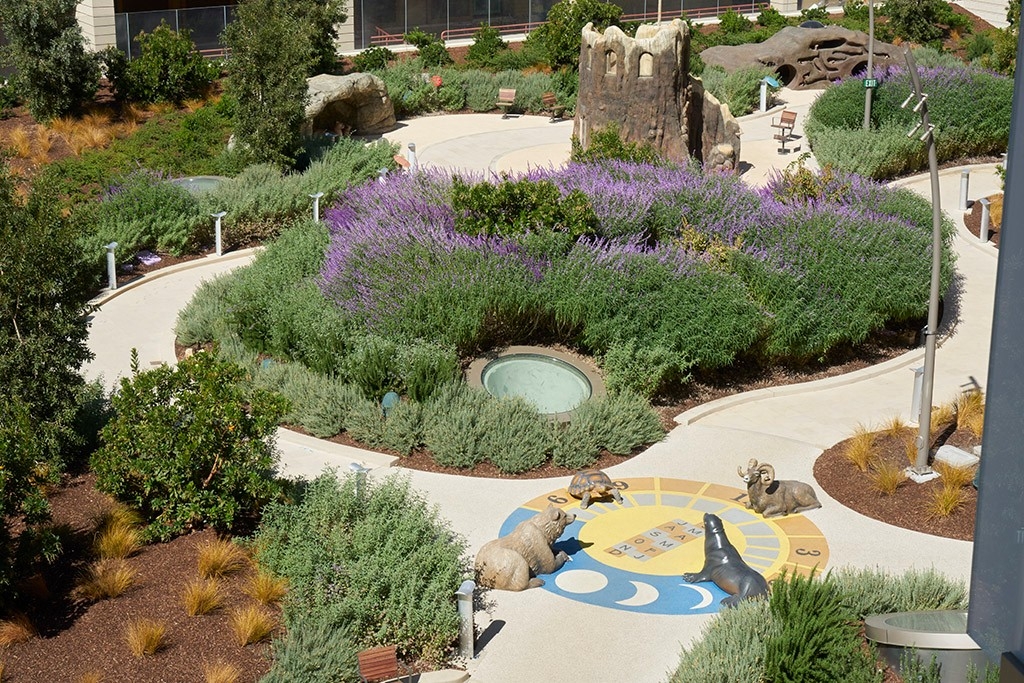At a glance
Highlights of the new Lucile Packard Children's Hospital Stanford

Nearly 15 years in the making, the new Lucile Packard Children’s Hospital Stanford more than doubles the size of the existing facility by linking a new main building with the original campus. Here’s what you can expect:
Related reading
New Lucile Packard Children’s Hospital Stanford includes family, nature in care
Added features
The new hospital includes more space and other elements throughout the campus, with additions including:
• 521,000 additional square feet of building space designed to be easier to navigate and more open, welcoming and child-friendly.
• 420 parking spaces, including 22 electric vehicle charging stations.
• 149 new patient beds in rooms that have a family focus, bringing the combined hospital bed total to 361.
• Six new surgical suites to give physicians immediate access to imaging and other diagnostic equipment, bringing the total number of hospital surgical suites to 13.
• 3.5 acres of new garden and green spaces that highlight Northern California’s natural environment in plants and play spaces.
Technological advances
Innovative and advanced medical technologies make the facility more efficient and treatment more effective. They include:
• A neuro-hybrid suite for neurosurgery that combines diagnostic imaging services within the operating room. Neurosurgical patients are traditionally moved from the operating room to intensive care, then to imaging to determine whether a procedure was successful. But in the hybrid suite, surgeons have ready access to an MRI so they can re-image a patient to ensure a tumor has been completely removed before they finish the surgery. Avoiding multiple steps significantly shortens surgery times, which saves money and means patients spend less time under anesthesia and have shorter hospital stays.
• One of the nation’s only stand-alone combined PET/MRI scanners that is dedicated to pediatric patients and measures how their tissues and organs are functioning to understand how diseases are behaving in their bodies. This allows physicians to create a personal treatment plan for every patient. The machine, designed in part by Stanford University engineers, provides less radiation exposure and is smaller and less invasive than equipment used for adults, which makes imaging faster and more comfortable for children.
• A high-intensity focused ultrasound device that pairs ultrasound and MRI technologies to shrink or remove tumors using sound wave blasts. It is used primarily to treat bone tumors, some of which might have required surgery or even amputation in the past.

Space where kids can be kids
Features are included to help “normalize” children’s experiences in the hospital. Additions include:
• Playrooms on each floor for pet therapy, arts and crafts, and other activities that involve the whole family. Playrooms are designated by age group so all patients have age-appropriate activities.
• A wall of large digital, interactive screens and sensors in the lobby. Patients and visitors can select nature-based environments to display on the screen — including a sandy beach or underwater scene. Then they can move their arms around to virtually paint a rainbow in the sky, or swim alongside sea creatures, while their body movements appear on screen. The wall doesn’t require them to touch anything, which is important for controlling infection, particularly for patients whose immune systems are compromised.
Focus on sustainability
The new facility is built to ensure an environment-friendly approach.
• Gardens and green space are irrigated with rainwater, water from condensation extracted from dehumidifying indoor air and wastewater from the hospital’s hemodialysis filtration system. These water sources are collected in two 55,000-gallon underground cisterns. This is expected to save 800,000 gallons of water a year.
• Water-conserving dishwashers and sterilizers, on-demand sinks, low-flow bathroom fixtures and the elimination of water-cooled pumps and air compressors are expected to result in an estimated 38 percent drop in water usage compared with a standard hospital.
• A shading system on the exterior of the building reduces solar gain (increase in temperature caused by the sun) and decreases the need for air conditioning.
• A dashboard in the main lobby displays ongoing energy and water usage — making it fun for kids and easy to see how much energy is being used in various areas of the campus.

